








If you had to name an inventor, would it be a woman? Or did you first think of a man like Thomas Edison or Alexander Graham Bell? Women haven’t always had equal opportunities to be inventors, or received as much recognition. But throughout American history, women with diverse backgrounds and interests created inventions that change our lives every day










TARA GRACE MARJORIE STEWART MICHELLE PATRICIA STEPHANIE AYAH KAVITA THERESA ELLEN LISA HINDA ALEXIS SHARON CYNTHIA MADISON AMY MÁRIA MARILYN HOPPER JOYNER ASTIGARRAGA BATH KHINE KWOLEK BDEIR SHUKLA DANKOVICH LEWIS OCHOA LINDAHL MILLER MAXEY ROGONE BREAZEAL PRIETO TELKES HAMILTON
Picturing Women Inventors is organized by the Sm thsonian Institution Traveling Exhib tion Service, n collaboration with the Lemelson Center for the Study of Invention and Innovation and the United States Patent and Trademark Office, and is sponsored by Lyda Hill Philanthropies IF/THEN Initiative and Ericsson Except where noted images courtesy of Smithsonian National Museum of American History
Anyone who is curious and creative can be an inventor!

A Latina Astronaut and Musician
Ellen Ochoa
studied physics in college and played the flute in the marching band She earned a PhD in electrical engineering, got a job at NASA, and dreamed of going to space Although she was not selected for the astronaut program on her first try, she didn’t give up, and became an astronaut in 1991 When she flew aboard the Space Shuttle Discovery in 1993, she was the first Latina in space and she took her flute with her She went to space three more times, became the director of NASA’s Johnson Space Center, and applied her training to inventing devices that help scientists analyze images from space


A Native American Linguist and Computer Scientist
Tara Astigarraga,
A Black Hair Stylist and Educator
Marjorie Stewart Joyner a member of the Choctaw Nation, studied Spanish linguistics and communications in college and planned to become either a bilingual teacher or a social worker An internship at IBM changed all that, sparking a passion for software engineering With more than 75 patents to her credit, she has invented storage, networking, security, and blockchain solutions For her inventions and her mentorship of Native Americans and women pursuing careers in science, technology, engineering, and math (STEM), Astigarraga was named an IBM Master Inventor
(1896–1994) opened her beauty salon in 1916 She trained with Madam C J Walker, a pioneer of the modern African American hair care and cosmetics industry, and was in charge of more than 200 Walker beauty schools Joyner was also an inventor Frustrated with the slow process of curling or straightening hair with a single iron, she invented a hair waving machine in 1928 Its multiple curling irons, heated by electricity, saved time by styling entire sections of hair at once
Marjorie



Ochoa courtesy of NASA; Joyner beauty school courtesy of V vian G Harsh Research Collection of Afro-American History and Literature Ch cago Public Library; Ast garraga photo by Lori & Erin courtesy of IBM; Astigarraga patent courtesy of USPTO
Ochoa training at Vance Air Force Base Houston 1993
Stewart Joyner 1950 Tara Astigarraga at her computer, 2020 Drawing from Astigarraga s US Patent 10 586 447 for a smart traffic signal system 2020 Astronaut Ellen Ochoa 2002
Stewart Joyner taught thousands of Black stylists in Madam C J Walker beauty schools Picturing Women Inventors is organized by the Sm thsonian Institution Traveling Exhibition Service, in collaboration with the Lemelson Center for the Study of Invention and Innovat on and the United States Patent and Trademark Office, and s sponsored by Lyda Hill Philanthropies IF/THEN Initiat ve and Ericsson WHO GETS TO BE AN INVENTOR?
Marjorie


Stephanie Kwolek
While visiting her grandmother in India, twelve-year-old Kavita Shukla accidentally drank contaminated water Her grandmother brewed a spice tea for her so she wouldn’t get sick Back at home, Shukla wondered how that tea worked and started an experiment to find out When she applied the spices to fruits and vegetables, they stayed fresh longer She then embedded the spices in paper that could be placed with the produce and patented the idea during her senior year of high school Shukla hopes that her all-natural product FreshPaper will help end food spoilage and waste especially in areas where refrigeration isn’t available

Chemist(1923–2014) joined DuPont in 1946 a time when few women worked in corporate labs When she was tasked with researching extra strong polymers in 1964, Kwolek focused on liquid chemical solutions in which all
molecules
up end-to-end, like a string of pearls Her experiments resulted in the invention of Kevlar, an incredibly strong, stiff, and lightweight synthetic fiber that has thousands of applications, from sporting equipment to protective gear
“All sorts of things can happen when you’re open to new ideas and playing around with things.”
STEPHANIE KWOLEK


Ideas have no age limits. Stephanie Kwolek with spool of Kevlar fiber 1996 Kavita Shukla in high school 2002
2017 Stephanie Kwolek 1982 Picturing Women Inventors is organ zed by the Smithson an Institution Traveling Exhibition Service in collaboration with the Lemelson Center for the Study of Invention and Innovat on and the United States Patent and Trademark Office, and is sponsored by Lyda Hill Ph lanthropies IF/THEN Initiative and Er csson Shukla n lab coat photo by Donna Coveney courtesy of Lemelson-MIT Program; Shukla n kitchen, courtesy of Kavita Shukla; Kwolek at desk, courtesy of Hagley Museum and Library
Kavita Shukla
DO I HAVE TO BE TO INVENT? HOW OLD Any Age is the Right Age to Invent You’re Never Too Young
the
line
HAVE AN IDEA…

“I believed that learning through play was the surest path to loving STEM.”
AYAH BDEIR
Inventions start in your imagination.
Make Inventing Fun
Ayah Bdeir
grew up in Lebanon As a child, she often took apart (and reassembled) her family’s electronic equipment so she could understand how it worked After earning an engineering degree in Beirut, Bdeir moved to the United States for graduate study at the MIT Media Lab She began an “experiment to make engineering and inventing more fun.” Her prototypes became littleBits, a system of color-coded, magnetic, electronic building blocks Bdeir says her littleBits blur the boundary between a toy and a tool kit, so makers of all ages can explore the connections between art and engineering through invention

Make Sports More Accessible
Lisa Lindahl
was one of millions of Americans who started jogging as part of the running and fitness boom that swept the United States in the 1970s But as much as she loved running, it was painful because she didn’t have a supportive bra Lindahl teamed up with costume designers and to solve that problem They deconstructed two men’s athletic supporters and sewed the pieces into a prototype sports bra they called “Jogbra ” Lindahl and Miller first sold their invention through mail orders and quickly expanded into a successful company


Make Robots More Like People
Cynthia Breazeal
excelled at sports and school, but in the third grade, she discovered another interest robots Inspired by the television show Star Trek, she wrote a fictional story about a pie-stealing robot created by the warrior Klingons Her robot showed human emotions, marking the beginning of her quest to invent social robots that can interact with and learn from people. Beginning in the 1990s, she applied theories about child development to her early robots Kismet (shown, right) and Leonardo, giving them expressive faces and voices that encouraged natural communication between people and machines


 Ayah Bdeir with littleBits
Ayah Bdeir with littleBits
2015 littleBits LED Matrix Code Kit Kismet (from the Arabic for fate ) could analyze a person s voice and express an emotional response Jogbra promotional flyer, early 1980s Picturing Women Inventors is organized by the Smithsonian Institution Traveling Exhib tion Service in collaborat on with the Lemelson Center for the Study of Invent on and Innovation and the United States Patent and Trademark Office and is sponsored by Lyda Hill Philanthrop es IF/THEN Initiative and Ericsson Bdeir photo by Mike Senese for Make: Magazine and littleBits both courtesy of Ayah Bdeir; Breazeal courtesy of Cynthia Breazeal; Kismet courtesy of Sam Ogden/Science Source
Lisa Lindahl (left) and Hinda Miller 1991
Cynthia
Breazeal with Jibo her personal assistant robot about
I
Hinda Miller
Polly Palmer Smith
DO INVENTORS NEED?

“Independence is a right that everyone deserves to have in their lives.”
MARILYN HAMILTON

Overcoming Barriers Through Teamwork
Marilyn Hamilton
After a hang gliding accident in 1978 that left her paralyzed, was determined to continue her active lifestyle, but her heavy wheelchair made that difficult Drawing inspiration from the materials used in hang gliders, she worked with two friends to invent a lightweight wheelchair that was easy to maneuver She co-founded Motion Designs in 1979 to manufacture her wheelchairs, still sold today under the brand name Quickie Hamilton’s many accomplishments as an athlete include two women’s wheelchair singles titles in the US Open tennis competition
Being a Creative Problem-Solver
Madison Maxey has always loved making things from clothing to stretchy inks that conduct electricity She started sewing when she was eight years old and began her design career by interning in the fashion industry She has since broadened her exploration of how technology and design can work together through innovations in electronic textiles (e-textiles) Maxey and her company, LOOMIA, create fabrics that act like circuit boards for innovative products that range from medical wearables for monitoring patients to heated ski gear
“I make a strong effort to keep my eyes and heart open to every possible opportunity ”
MADISON MAXEY



Inventors bring curiosity, imagination, determination, and a love of learning to whatever they invent.
Hamilton, 1983 Illustration from Maxey s patent application for a flexible heating element for shoes clothing and other soft goods 2018 Hamilton invented this sports wheelchair (now at the Smithsonian) and competed in it as a tennis champion Picturing Women Inventors is organized by the Smithsonian Institution Traveling Exhib tion Service in collaborat on with the Lemelson Center for the Study of Invent on and Innovation and the United States Patent and Trademark Office and is sponsored by Lyda Hill Philanthrop es IF/THEN Initiative and Ericsson Hamilton photo by Nancy Crase courtesy of Sports N Spokes; Maxey patent appl cation courtesy of USPTO; Maxey courtesy of Madison Maxey
Marilyn
WHAT SKILLS


Helping the Smallest Patients
As a neonatal intensive care unit (NICU) nurse for more than 25 years, understood the needs of premature babies Standard infant medical supplies were impractical for her tiny patients, so Rogone began inventing specifically for preemies One of her first products, invented in 1997, was a mask that protected babies’ eyes from the harsh lights used to treat jaundice caused by high levels of bilirubin, a yellow-colored pigment in blood She started Small Beginnings in 1995 to create and market diapers, pacifiers, and other necessities that she and other nurses invented


Caring about others can launch ideas that make a difference in many lives.
Diagnosing Disease With a Toy
Michelle Khine


Providing Safe Drinking Water
Millions of people worldwide get sick from contaminated drinking water saw a way to prevent illness by using nanoparticles that naturally kill bacteria and viruses
Theresa Dankovich
As a graduate student, she invented germ-killing water filters made of thick paper embedded with silver nanoparticles The filters are inexpensive, easy to distribute, reusable, and biodegradable She founded Folia Water in 2016 to produce her invention, which is being tested extensively around the world

A woman in South Africa using a Folia Water filter 2016 One version of Khine s Shrinky Dinks device has wells for growing cells Michelle Khine 2013
2016
Theresa Dankovich
Sharon Rogone around 1995
Picturing Women Inventors is organized by the Smithsonian Institution Traveling Exhib tion Service in collaborat on with the Lemelson Center for the Study of Invent on and Innovation and the United States Patent and Trademark Office and is sponsored by Lyda Hill Philanthrop es IF/THEN Initiative and Ericsson Kh ne patent image courtesy of USPTO; Kh ne courtesy of Michelle Kh ne; South African woman courtesy of Folia Water
MY INVENTION SAVE A LIFE?
engineerknew that parts of the world with limited healthcare often had drugs to treat disease but not
capability
diagnose
the ink left ridges
as
mold, creating channels to hold small amounts of bodily fluids, like blood or saliva, for testing
more accessible and affordable
The Bili-Bonnet mask protected babies’ eyes from the harsh lights used to treat jaundice
CAN
Biomedical
the
to
it early So she adapted her favorite childhood toy Shrinky Dinks into a low-cost device for medical diagnostic tests Khine first created patterns on Shrinky Dinks sheets with a laser printer When she baked the Shrinky Dinks,
that she used
a
Khine’s inexpensive miniature devices make diagnosing treatable diseases
Sharon Rogone


Mária Telkes

Colombian-born inventoris creating safe, inexpensive, fast-charging, and environmentally friendly rechargeable batteries, with potential applications in everything from smart phones to electric vehicles She joined the Colorado State University chemistry department in 2005 and started her company, Prieto Battery, in 2009 to take the battery from research to prototype to commercialization Still in development, Prieto’s solid-state batteries contain none of the toxic components found in
Amy Prieto


Inventions in clean energy are just one way to help the planet. Picturing Women Inventors is organized by the Sm thsonian Institution Traveling Exhibition Service n collaboration with the Lemelson Center for the Study of Invention and Innovat on and the United States Patent and Trademark Office and s sponsored by Lyda Hill Philanthropies IF/THEN In tiat ve and Ericsson Prieto photo by Joe Mendoza courtesy of Colorado State University; Popular Sc ence cover courtesy of Google Books; Telkes courtesy of L brary of Congress HOW CAN I HELP THE ENVIRONMENT? The solar heating system designed by Mária Telkes was featured on the cover of Popular Science, March 1949 Amy Prieto 2009 Mária Telkes 1956 Prototype Prieto batteries on testing board 2014
in
completing
physical chemistry
nicknamed
Queen” for her work on solar energy, inventing solar stoves and a solar-powered distiller to desalinate sea water In the 1940s, she worked with architect Eleanor Raymond on a solar-heated house Photovoltaic panels were still experimental, so the house was built with large windows backed with black metal sheets Sunlight heated the sheets and fans circulated the warmed air around bins filled with a chemical salt The salt melted and stored heat until the temperature around the bins cooled Then the salt recrystallized, slowly releasing the absorbed heat
Solar Energy Non-Toxic Batteries Born in Hungary, (1900–1995) immigrated to the United States
1925 after
her PhD in
She was
the “Sun
other batteries
Inspiration for invention can come from anywhere. Are there things you would like to change or make better?

Keeping Families Together
In 2011, twelve-year-oldwas inspired to invent after reading about children who became lost when their families fled the famine in Somalia She adapted a traditional Native American sled called a travois by adding wheels to create a simpler way to transport families and their belongings Alexis continues to invent she has a patent pending for an emergency smoke filtration kit that can be thrown to someone trapped in a burning building and she is inspiring other young inventors through invention education
“Getting frustrated only stops you.”
A Right to Sight Computing for All
Dr. Patricia Bath
Cataracts are a clouding of the lens of the eye that cause blurry or distorted vision and can lead to blindness Ophthalmologist and surgeon (1942–2019) invented the Laserphaco Probe in 1981 to make cataract removal faster, easier, more accurate, and less invasive Using the innovative device a surgeon inserts an optical laser fiber through a tiny (1 millimeter) incision in the eye to vaporize
replacement lens is inserted Patented in 1988, Dr Bath’s invention has improved the sight




(1906–1992) was a math professor at Vassar College when she joined the US Navy Women’s Reserve (the WAVES) during World War II Posted to Harvard’s Cruft Laboratory, she became one of the first programmers, writing code for the Mark I electromechanical computer In 1952, she invented pioneering “compiler” software that translated the instructions of human programmers into computer code, making communication between people and computers more user-friendly “The computer should learn how to respond to people,” she noted


cataract Then a
millions
the
of
worldwide
Alexis Lewis
Dr Patricia Bath, 1994 Alexis Lewis 2015 Figure from Lewis’s US Patent 8,979,095, issued in 2015 Lewis modeled her invention after the travois used by Native Americans to transport people and goods Grace Hopper around 1945 Dr Bath dissected cow eyes with middle school students at the Smithsonian 2000 Hopper inspects the Mark I 1944 Picturing Women Inventors is organized by the Smithsonian Institution Traveling Exhib tion Service in collaborat on with the Lemelson Center for the Study of Invent on and Innovation and the United States Patent and Trademark Office and is sponsored by Lyda Hill Philanthrop es IF/THEN Initiative and Ericsson Bath courtesy of Eraka Bath MD; Lewis photo by Michelle Fishburne courtesy of Alexis Lew s; Lewis patent appl cation courtesy of USPTO
YOU? I NSPI R ES
Grace Hopper
WHAT
GRACE HOPPER
























































